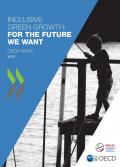The report takes stock of the latest developments in the overall economic and social conditions in EECCA countries, market signals and environmental governance arrangements that may facilitate the shift towards green growth, and discusses possible barriers and measures to overcome them. At the same time, the report delineates the possible elements of a more coherent and effective reform agenda. In such a way the report aims to serve as background and a starting point for follow up development of green growth policies in EECCA.
The report contains profiles of the following countries: Armenia, Azerbaijan, Belarus, Georgia, Kazakhstan, Kyrgyzstan, Moldova, Russian Federation, Tajikistan, Turkmenistan, Ukraine, and Uzbekistan

In many OECD countries, governments have invested large amounts of public money to support renewable energy (RE) development and are requiring significant quantities of it to be sold by energy providers. But what are the economic impacts of these policies on the rural regions where deployment takes place? How can RE bring the greatest benefit to host regions?
These are some of the questions explored by this study. Drawing on case studies in 16 regions within 10 countries, the research finds that while RE indeed represents an opportunity for stimulating economic growth in rural communities, its development benefits are not automatic.
Realising them requires a complex and flexible policy framework and a long-term strategy, as well as a realistic appreciation of the potential gains from RE deployment. Making a positive connection between RE development and local economic growth will require more coherent strategies, the right set of local conditions, and a place-based approach to deployment.
This report presents and analyses policies, programmes and approaches for the development, market introduction and diffusion of green cars. It reviews government policies (including public procurement and regulations and standards) in a number of OECD countries as well as a selection of non-OECD economies. The report attempts to provide: i) a better understanding of the growing market for green vehicles; ii) new analytical instruments to identify policies and approaches that could be designed and put in place, notably with the aim of fostering the uptake of green cars; and iii) to the extent possible, insights into the efficiency and effectiveness of existing policies, as well as guidance on how to assess the impact of future measures.
The greening of the labour market will create new opportunities for workers, but also new risks that could undermine political support for green growth policies. Accordingly, labour market and skills policy should also seek to maximise the benefits of green growth for workers while assuring that unavoidable adjustment costs are shared fairly. This report aims to provide guidance for how best labour market and skill development policy can contribute to a fast, efficient and fair transition to a low carbon and resource efficient economy, particularly in developed countries.
